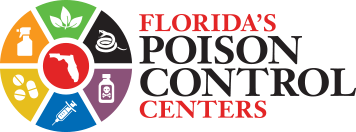For Kids & Parents
For Parents & Caregivers
Poisoning Prevention
Poisonings can happen quickly. Parents should take extra care to make sure all poisons and medicines in the household are out of children’s reach. To illustrate the seriousness of poison in the home, review these facts:
FACT: Anything can be poisonous in excessive amounts.
Medications taken in their proper dose can be helpful, but an overdose can cause serious illness or death. Vitamins and minerals are essential to good health, but too many may be toxic. Anything can be dangerous if excess amounts are taken — even water!
FACT: We use poisons every day.
Approximately 400 potentially toxic substances enter the average home each year. Household products become potentially harmful when splashed in the eye, in the mouth or on the skin.
FACT: Some people are more at risk than others.
Toddlers aren’t aware of all the things that can hurt them. They explore their world by putting things into their mouths. They will even eat things that taste and smell bad.
Top Five Poisons Commonly Ingested by Children:
- Medications
- Household cleaners
- Cosmetics and personal care products
- Foreign bodies (coins, watch batteries)
- Plants, berries and mushrooms
FACT: Poisons can be used safely.
Follow these tips to increase the safety of your home:
- Read the label. Always follow directions on the package.
- Poisonings can occur when a product is in use and within reach. Never leave poisons unattended if children are nearby.
- Is it medicine? Call it medicine, not candy.
- Take medicines where children can’t observe. Children learn by imitation.
FACT: Poisons can be stored safely.
The following safety measures can help prevent accidental exposure:
- Put child-resistant latches on cabinets containing non-food products.
- Store poisons in cabinets away from food or drinks.
- Keep products in their original container.
- Remove poisonous house and yard plants. Determine the names of plants. Find out if plants are toxic by calling 1-800-222-1222.
- Program the number for the poison center on your telephone, post on the refrigerator or place in your wallet to be ready in case of emergencies or questions.
Room-By-Room Safety in the Home
Conduct a room-by-room survey for hazards.
Remove or lock up the products listed below. Print this page or download the Poison Patrol Checklist for easy reference.
Kitchen
- Ammonia
- Cigarettes/chewing tobacco
- Cleaners: oven/drain/surface/dish
- Detergents
- Furniture polish
- Medicines/vitamins/herbal supplements
- Alcoholic beverages
- Plants
Bathroom
- Air fresheners
- Cleaners: toilet bowl/sink/shower
- Cologne/perfume
- Hair remover
- Personal care products
- First aid products
- Medicines/vitamins/herbal supplements
- Mouthwash
- Nail polish/polish remover
- Rubbing alcohol
- Shaving cream/after-shave lotion
Garage
- Antifreeze
- Windshield wiper fluid
- Bug/weed/pest killer
- Fertilizer
- Gasoline/kerosene
- Lighter fluid
- Mothballs
- Paint/paint thinner
- Pool supplies
- Turpentine
Laundry Room
- Laundry detergents
- Bleach
- Fabric softeners
Yard
- Bug/weed/pest killer
- Fertilizer
- Mushrooms
- Plants/berries/flowers (for information about medical problems associated with plants, refer to this chart)
- Shrubs/trees
Prevent Look-Alike Poisoning
Many poisonous products look good enough to taste — especially to a child. Follow these poison safety tips to prevent a look-alike accident from taking place:
- If a poison is stored in a food or drink container, someone could swallow it accidentally.
- Some chemicals must be mixed with water before use. If you plan to store the chemical mixture in a different container, apply a label and lock it in a safe storage area.
- Always turn on the lights to read labels before taking medication.
- If you can’t eat or drink it, don’t place it in the refrigerator.
Call your Poison Control Center at 1-800-222-1222 for first aid advice after a poison is tasted, touched or inhaled.
Download our Poison Look-Alike PDF to share with your friends and family.
Games
Download these fun games to reinforce lessons and activities about poison safety.
Child Maze
Stan the Scorpion needs help to get away from the poisons. Can you get him to his home that has been poison-proofed?
Avoid the Poisons Maze. Follow the ladders by only choosing the foods and avoiding the poisons to stay safe.
Word Search
Bobby wants to learn what things are poisonous. There are 20 poisonous substances hidden in here. Can you help Bobby find them all?
Poisons in the House! Find and circle the hidden poisons in this house. These poisons might lurk in your house too!
Word Scramble
Can You Help Gigi? Gigi Good Gator wants to help you patrol your house for poisons but they are all mixed up. Can you help Gigi fight poisonings by unscrambling the puzzle?
Crossword
Meet Widow the Spider! Widow needs your help to determine the animals that may bite or sting. Use clues to solve the puzzle.
Coloring Page
Meet Coral the Snake. Fill in her colors in the right order. Red on yellow, kill a fellow! Make sure her nose is black and her yellow and red bands are touching.
Links/Videos
Safe Kids Worldwide: Poison Prevention
American Association of Poison Control Centers: Prevention
Up Up and Away: Center for Disease Control: Educational program reminds families of the importance of safe medicine storage and provides information and advice on keeping children safe from medication overdose.
Choose Your Poison: ‘Pills v. Candy” Quiz from CA Poison Control: Game from the California Poison Control System with three levels of difficulty that demonstrate how pills, poisons and candy can all look alike.
Download Our Fact Sheets
Download our Fact Sheet for Parents
Download our Fact Sheet for Kids

